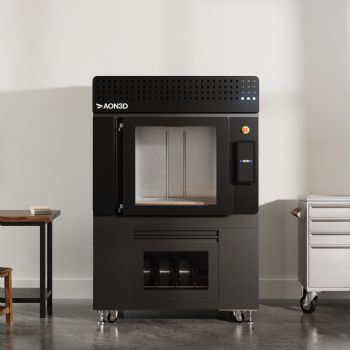 AON3D
AON3D, a Canadian manufacturer of industrial 3-D printers and software, recently introduced two new products: Hylo, a new ‘smart’ high-temperature 3-D printer; and Basis, an additive manufacturing (AM) software system equipped with process simulation, machine-learning-driven thermal optimisation, and part qualification tools.
The company says that together, the two solutions “simplify and expedite the process of printing ‘open market’ materials, carbon-fibre composites, and high-performance polymers — materials that offer, among other things, greater specific strength than many metals, withstand continuous use at temperatures up to 260°C, and exhibit extreme chemical resistance.
Hylo features a build volume of 650 x 450 x 450mm, a 250°C chamber, 3-D print speeds of up to 500mm/sec and IDEX-enabled duplication/support modes. The unit also features advanced process control and monitoring, as well as thermal optimisation software and over 25 integrated sensors that allow it to continually monitor, control, and compensate for process variability.
AON3D said: “Currently, many high-temperature 3-D printers and accompanying software struggle to print high-performance polymers, like PEEK and Ultem, as a result of antiquated, open-loop hardware/software architectures and slicers that lack material-specific thermal awareness. Current material extrusion printers rely on workaround solutions, like reducing variability by locking down materials and process settings or using ‘one size fits all’ process parameters.
AON3D’s Hylo and Basis solve these limits by leveraging process simulation and automation to integrate material awareness into the slicing process, adding material-specific thermal awareness to this process, and dynamically tuning process parameters to optimise properties such as layer weld strength, dimensional accuracy, and surface finish.
“Furthermore, with AON3D Basis, users can quickly verify printed part quality by viewing Hylo’s process monitoring data in three dimensions; and while many high-temperature 3-D printer manufacturers offer rudimentary thermal maps, AON3D’s quality control tool also captures warping/cracking, over/under extrusion, filament diameter variances, hidden defects, dross/debris inclusion — and more.”